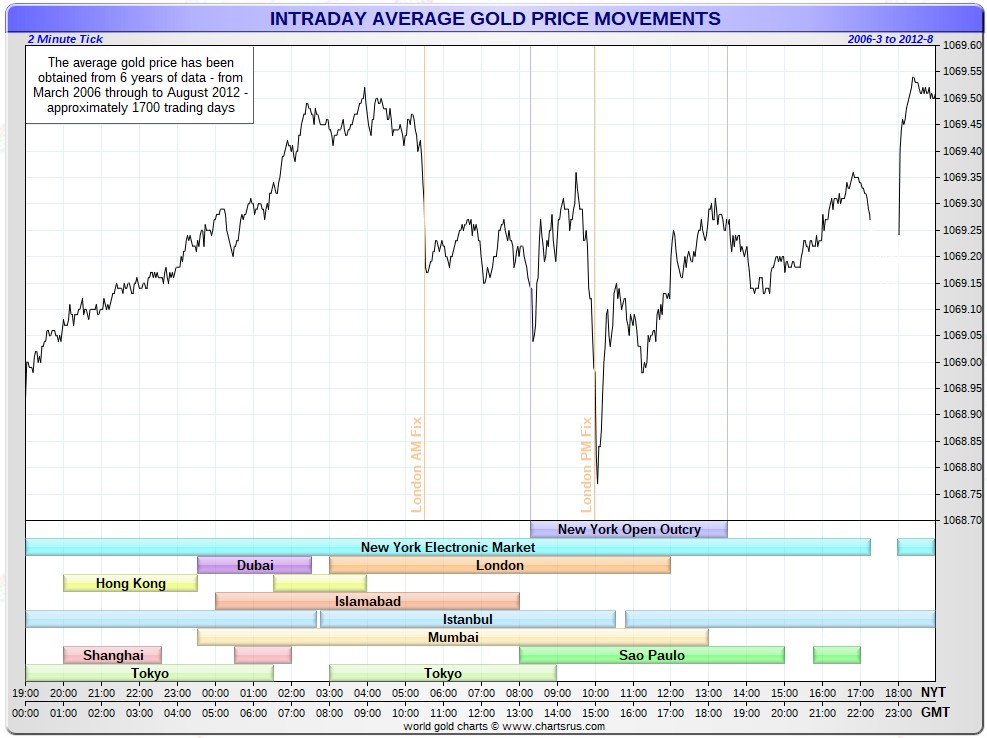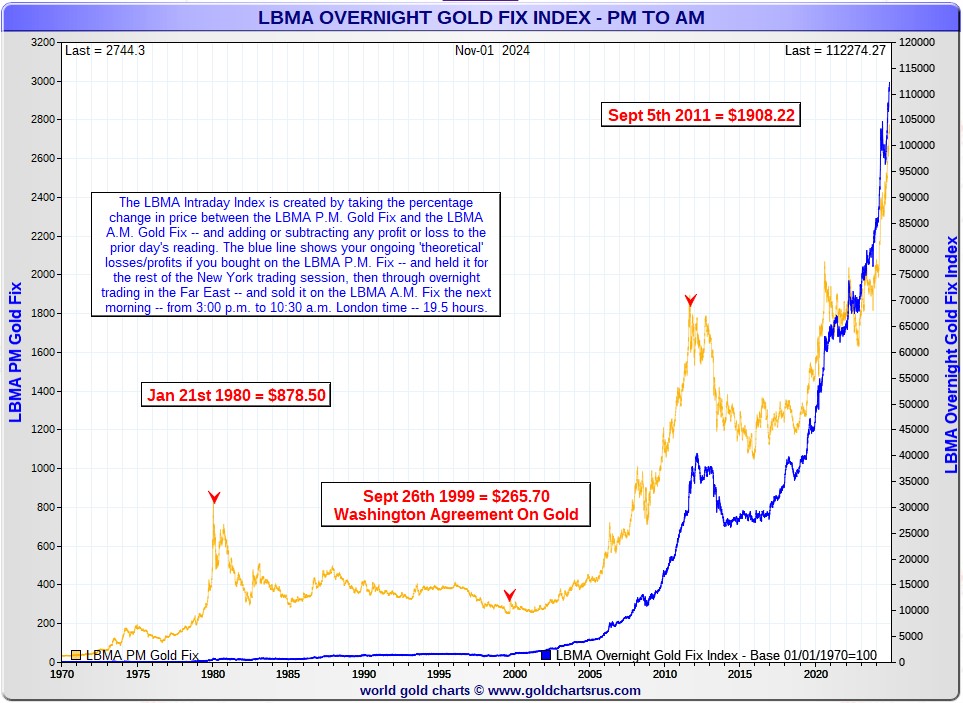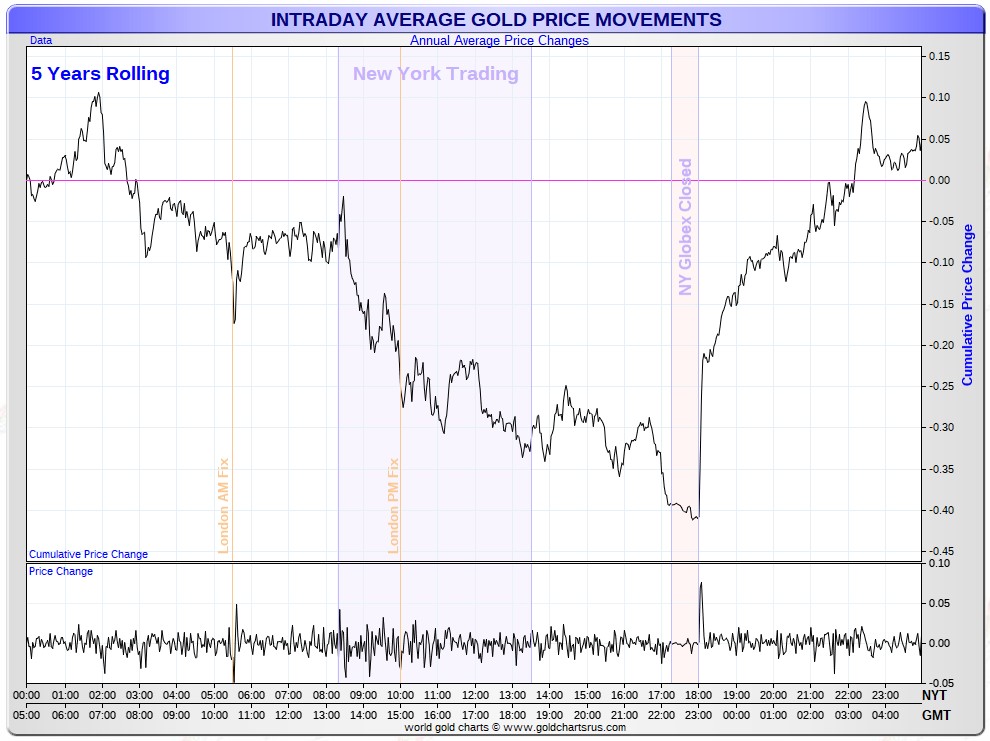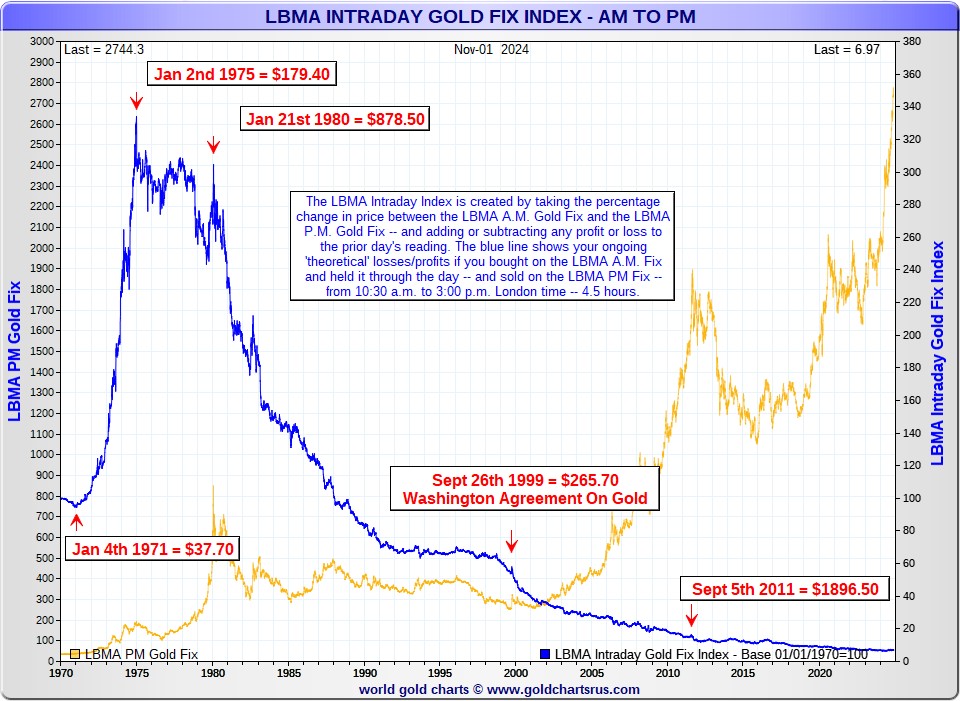Back in early March of 2015 I penned an essay with an identical headline… except for the year. It was something I presented at a Casey Research conference in San Antonio, Texas way back then. So, after almost ten years, it’s time for a revisit — and update.
[Note: I’d link the original article from the Casey Research website, but it’s no longer active.]
Both of the relative charts are simplicity themselves. The yellow line is Nick’s proprietary LBMA a.m. and p.m. gold fix index for the last 54 years — and slaved to the left axis. The blue trace is the theoretical value of an original $100 investment [ignoring any commission or transaction fees] — and is slaved to the right axis. Click to enlarge.
This first chart shows what happened to your $100 investment if you’d bought at the 10:30 a.m. GMT morning gold fix in London — and then sold it at the 3:00 p.m. GMT afternoon gold fix starting on the first trading day of January 1970…then reinvested that $100…plus or minus any gains or losses…the following day at the morning gold fix — and sold again at the p.m. fix once again.
If you did this every business day for 54 years, your initial $100 investment would be worth US$6.97 today. Of course that doesn’t include the loss due to currency debasement over that time…so in other words, you lost everything.
How is that possible since gold’s low tick of US$37.70 on 04 January 1971 — and its US$2,749.20 December contract close on 01 November 2024?
In the beginning, your $100 investment had risen to around $335 by January 2, 1975…when gold rose from $37.70 to $179.40…see the red arrow…and then stalled there.
What happened on that date? That’s when the COMEX futures/paper market in gold commenced in New York. Then something strange began to happen. From that point on, the morning gold fix in London…with exceedingly few exceptions …was always higher than the afternoon gold fix. The chart below from Nick Laird only covers a few years…from March 2006 until August 2012…but it proves the point. Click to enlarge.

That’s why, despite the fact that the gold price rose from $179.40 on January 2, 1975…up to $878.50 on January 21, 1980…that your $335 investment got whittled down to about $305 at gold’s high tick way back then….despite gold’s $700 gain during that 5-year time period.
Don’t forget that you’re reinvesting your proceeds at the morning fix — and selling at the p.m. fix — and if the latter is always higher than the former… then your investment gets whittled away in the process…regardless of what happened between the fixes, or after them, during that time period. After 54 years, your hundred bucks is down to the aforesaid mentioned US$6.97 which wouldn’t buy you a decent caffè latte at Starbucks.
That’s the power of a higher a.m. fix — and a lower p.m. fix over the long term on an investment strategy such as this…which is only theoretical — and can’t be pulled off in real life. I don’t know how old you were at the time this all started, dear reader…but I was 21 years young at the beginning of 1970 — and turned 76 last month.
However, there is a flip side to this — and that scenario goes as follows on this next chart: If you’d invested your theoretical $100 at the afternoon gold fix London…held that investment until early in the Far East Globex trading session overnight — and then sold at the morning gold fix in London, the chart looks this…Click to enlarge.

Of course Nick’s LBMA Gold Fix Index trace is identical to the one in the first chart. What’s different is the blue line…your original $100 investment from January 1970. By the time the Washington Agreement on Gold was signed on 26 September 1999…your $100 bucks had morphed into about $1,000 as shown by the blue line…not a terrific gain after almost 30 years. But from thereon in, everything changed — and as of the close of trading on 01 November 2024…that theoretical $100 invested 54 year ago had morphed itself into $112,274.27.
This simple difference in investment strategy is all the proof needed that the world’s banks and large commercial traders are actively managing the price between the a.m. and p.m. gold fixes in London — and have been doing so since the paper market in gold first opened on 02 January 1975.
And if you think that $112,000 is an outrageous gain, it would be even more so if you’d sold either at the 9 a.m. China Standard Time open in Shanghai every day…or minutes before 2 p.m. CST over there…when gold prints its highest intraday average prices on a 5-year rolling price basis — and not waited for the morning gold fix in London. Click to enlarge.

You’ll note that this chart is for the last five years as of the close on Friday, November 1 — and has a far different ‘shape’ to it compared to the similar chart from earlier years posted further up. That’s because the Anglo/American gold price suppression scheme has become much more blatant [and therefore more obvious] as the years have rolled by. Even now, the morning London gold fix is still higher than the afternoon gold fix…but not nearly as extreme as it was 15 or so years ago.
The scales on those two charts aren’t quite the same…but the shapes of the traces on the charts tells you all you need to know. What is most noticeable on the above 5-year chart is that from gold’s high tick in Globex trading in the Far East on any average day…it’s all down hill from there until trading ends at 5:00 p.m. in New York.
There is nothing free market about anything you see on the above charts from 02 January 1975 onwards…except maybe what happens between the 6:00 p.m. Globex open in New York — and until gold’s high ticks are set in Shanghai the following day. The rest is pure price management to the downside.
And as ugly and obvious as this price management scheme has been in gold over these last 54 years…the travesty that has existed in the silver market over the same time period is even more obscene and grotesque — and has no parallel in all of human history.
Nobody knows what the true free-market prices of either of these precious metals really is…as they’ve never been allowed that luxury. But one thing is for sure is that they are many, many multiples of what they’re trading at today…silver in particular, as you already know.
These are two of the biggest Gordian Knots that will have to be unravelled in the upcoming ‘Great Reset’…in whatever form it manifests itself. And, whether that day arrives either by design or by circumstance, a ‘New World Order’ of one type or another will be upon us when they are.
Ed
Read the full article here

